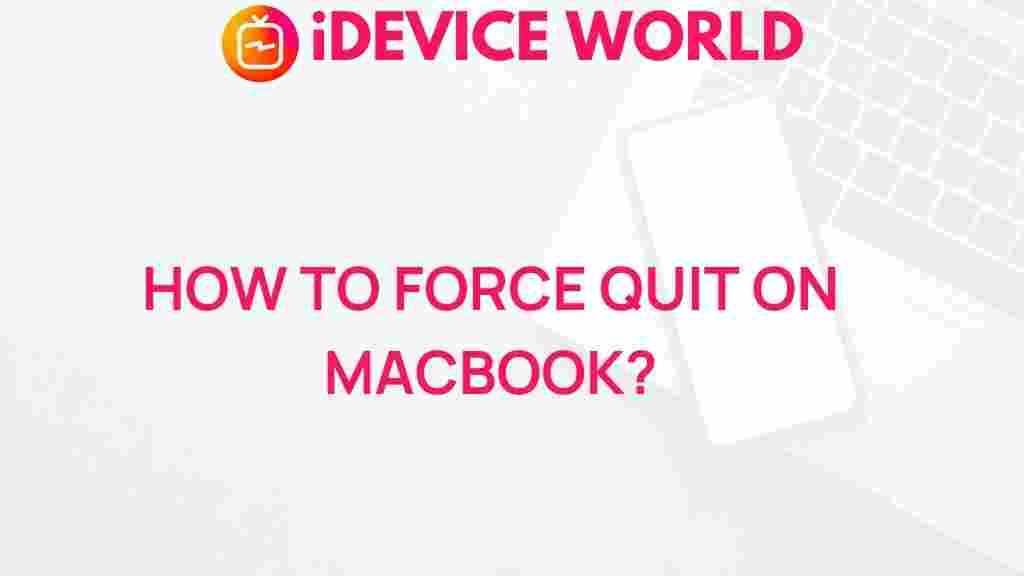Unleash the Power of Force Quit on MacBook
When working on your MacBook, you might encounter situations where applications become unresponsive or slow down your system. In such cases, knowing how to force quit these applications can save you time and frustration. This article will guide you through the process of using the force quit feature effectively, provide troubleshooting tips, and highlight its benefits.
What is Force Quit?
Force quitting is a method used to close applications that are not responding. This feature can be crucial when an application freezes or becomes sluggish, allowing you to regain control of your MacBook without needing to restart the entire system. Understanding how to use this feature efficiently can enhance your productivity and streamline your workflow.
When to Use Force Quit
There are several scenarios where you might need to force quit an application:
- Application Freeze: When an app stops responding and does not allow you to close it normally.
- System Slowdown: If an application is consuming too many resources, causing the system to slow down.
- Crashes: In the event of an application crash, force quit can help you regain control.
How to Force Quit an Application on MacBook
Here’s a step-by-step guide on how to force quit applications on your MacBook:
Method 1: Using the Force Quit Menu
- Access the Force Quit Menu: Press
Command (⌘) + Option (⌥) + Escsimultaneously. This will bring up the Force Quit Applications window. - Select the Unresponsive Application: In the list of open applications, find the one that is not responding.
- Force Quit the Application: Click on the application name, then press the Force Quit button. Confirm your choice if prompted.
Method 2: Using the Activity Monitor
If the above method does not work, you can use the Activity Monitor to force quit an application:
- Open Activity Monitor: You can find it in
Applications > Utilitiesor search for it using Spotlight by pressingCommand (⌘) + Spaceand typing “Activity Monitor.” - Find the Application: In Activity Monitor, scroll through the list of running applications to locate the one you want to close.
- Force Quit from Activity Monitor: Select the application, then click the X button in the top left corner. Confirm by selecting Force Quit.
Method 3: Using Terminal Commands
If you prefer using command-line interfaces, the Terminal can be a powerful tool:
- Open Terminal: Navigate to
Applications > Utilities > Terminal. - Find the Application ID: Type
ps aux | grep [app name]to locate the application’s process ID (PID). - Force Quit Using Kill Command: Type
kill -9 [PID]to force quit the application, replacing “[PID]” with the actual process ID.
Benefits of Using Force Quit
Utilizing the force quit feature offers several advantages:
- Improved Performance: Closing unresponsive applications can enhance your MacBook’s performance.
- Time-Saving: Quickly regain control without needing to restart your computer.
- Prevention of Data Loss: Regularly force quitting problematic apps can prevent data corruption.
Troubleshooting Tips for Force Quit Issues
Sometimes, you may encounter issues when trying to force quit applications. Here are some troubleshooting tips:
1. Application Not Responding
If an application does not respond to the force quit command, try the following:
- Wait a few moments to see if it recovers.
- Use the Activity Monitor method for a more forceful closure.
2. Activity Monitor Not Opening
If you cannot access the Activity Monitor:
- Restart your MacBook in Safe Mode by holding down the
Shiftkey during startup, then try again. - Check if any system updates are pending, as these might affect performance.
3. Terminal Not Responding
If the Terminal freezes while executing a command:
- Try closing the Terminal window and reopening it.
- Consider using a different method to force quit the application.
Conclusion
Knowing how to force quit applications on your MacBook is an essential skill for maintaining optimal performance and ensuring a smooth user experience. Whether you choose to use the Force Quit menu, Activity Monitor, or Terminal commands, these methods provide quick solutions to unresponsive applications. By mastering the force quit feature, you can save time, enhance productivity, and prevent data loss.
For more information about managing your MacBook effectively, visit Apple Support. If you have further questions, feel free to check our other articles on MacBook tips and tricks.
This article is in the category Guides & Tutorials and created by iDeciveWorld Team

1 thought on “Unleash the Power of Force Quit on MacBook”